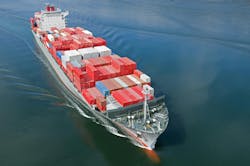Five Trends Shaping Shipping in 2025
The shipping industry is positioned for a wave of transformative changes influenced by political, environmental and technological forces that will impact businesses but also reverberate through supply chains worldwide, says Charles Haverfield, CEO of US Packaging & Wrapping.
He offers five key trends expected to shape the shipping landscape in 2025
#1 The rise of America-first policies means greater uncertainty
The resurgence of America-first policies promises to reshape the shipping and packaging industry in significant ways. A proposed tariff increase, of up to 20% on all imports and 60% on goods from China, aims to boost domestic production and reduce reliance on foreign suppliers.
However, for businesses relying on foreign suppliers, these tariffs will add layers of complexity to cost management and logistics, as companies brace for these changes by frontloading imports. The rush to beat tariff deadlines could lead to bottlenecks in warehouses and ports, creating a logistical hurdle that could impact the timeliness of shipments for months.
For consumers, the impact will likely be felt at the checkout counter. Businesses facing increased costs on imported goods will most likely transfer these expenses to consumers. Several businesses have already admitted to plans to hike prices for American customers as a direct result of these tariffs, as well as considering moving production operations outside of China.
We’re already beginning to see brands adopt domestic sourcing or regionalize their supply chains to nearby countries, a practice known as ‘friendshoring,’ to mitigate the impact of tariffs, such as Steve Madden.
At the same time, these policies may ignite retaliatory tariffs from trade partners, adding further strain on global supply chains and pushing companies toward reshoring or nearshoring solutions to reduce both costs and uncertainty.
#2 Sustainability initiatives will be in limbo
Despite years of pledges by companies and policymakers to prioritize environmental sustainability, 2025 may see some backpedaling in this area.
Many large corporations are nearing the deadlines they set for achieving sustainability goals, such as reducing plastic usage or carbon emissions. However, meeting these targets has proven challenging, and we may soon witness whether companies can follow through on their promises.
This year’s COP29 agreements included strong commitments to advancing carbon markets and limiting global temperature rises to the 1.5°C threshold set by the Paris Agreement. However, the current political landscape could complicate progress, especially given newly re-elected President Trump’s stance on climate change and his vow to remove the US from the Paris accord. Should US environmental policies soften under a new administration, this will slow or stall initiatives designed to address climate change and reduce plastic waste in packaging.
While many experts are warning that such rollbacks could have serious consequences, the industry could still see some sustainability efforts continue at the corporate level, with companies finding ways to achieve carbon neutrality through lightweight packaging and other innovative materials.
#3 Carriers will move away from 'actual weight' rates
As more companies rethink their pricing strategies, a shift from actual weight to dimensional weight pricing is likely to become the industry standard.
Instead of billing based solely on package weight, companies will consider the package size, rewarding smaller, more efficiently packed items and penalizing bulkier shipments that take up more space on trucks and planes. This shift will likely have a ripple effect on packaging design, encouraging businesses to adopt smaller, more flexible packaging solutions that minimize wasted space.
For businesses, dimensional-weight pricing offers an incentive to reassess the size and weight of their shipments to maximize shipping efficiency and reduce costs. As a result, more companies may adopt flexible packaging solutions and lightweight materials, which will help reduce shipping volumes and decrease the environmental footprint of each package.
#4 Paper packaging solutions will dominate
Even as environmental regulations face potential rollbacks, the demand for eco-friendly packaging remains strong.
Despite political shifts that may deprioritize climate initiatives, consumer preferences continue to drive brands toward sustainable choices, with recent studies indicating that over 60% of consumers prefer products with environmentally friendly packaging options, and consumers willing to pay up to 9.7% more for sustainably produced or sourced goods.
This demand has translated into a significant push for paper-based packaging as an alternative to plastic. In fact, the North American paper packaging market is projected to reach $116 billion by 2030, with an annual growth rate of 4 percent. Virgin paper, in particular, is poised for rapid expansion as brands turn to recyclable, biodegradable materials to align with consumers’ sustainability values and meet their demand for greener options.
Paper packaging offers an attractive alternative for brands looking to appeal to eco-conscious consumers while reducing their environmental footprint. Coupled with advancements in paper packaging technology, this shift underscores a long-term trend toward materials that satisfy consumer expectations and align with sustainability, regardless of the regulatory environment.
#5 AI’s role in transforming supply chains will increase
Artificial intelligence is expected to play an increasingly vital role in streamlining the shipping industry and optimizing supply chains in 2025. And with President Trump expected to loosen regulation around AI, we could see advancements much faster than expected.
The potential of AI to enhance efficiencies at every stage of logistics, from real-time inventory tracking to predictive analytics, will be transformative for the industry. By harnessing AI tools, businesses can minimize shipping delays and forecast demand with greater accuracy, allowing them to maintain optimal inventory levels and route shipments more efficiently. AI also enables a more data-driven approach to logistics, allowing companies to predict market fluctuations, reduce shipping costs and minimize the risk of supply chain disruptions.
The adoption of machine learning and AI technologies could help the shipping industry overcome challenges presented by tariffs, resource scarcity and rising operational costs, creating a more resilient and agile supply chain
